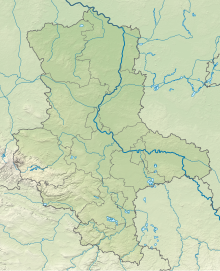Neue Göhle (nature reserve)
Coordinates: 51 ° 14 ′ 5 ″ N , 11 ° 46 ′ 56 ″ E
The Neue Göhle is a nature reserve in the town of Freyburg (Unstrut) in the Burgenland district in Saxony-Anhalt .
The nature reserve with the registration number NSG 0126 is around 53 hectares in size. It is completely part of the approximately 84 hectare FFH area “New Göhle and dry grassland north of Freyburg” and is almost completely surrounded by the landscape protection area “Unstrut-Triasland”. The area has been under protection since 1994 (date of regulation: June 20, 1994). The former nature reserve of the same name, which was designated as of May 1, 1961, was incorporated into it. The responsible lower nature conservation authority is the Burgenlandkreis.
description
The nature reserve is located north of Freyburg (Unstrut) in the Saale-Unstrut-Triasland nature park . It places areas with sessile oak-hornbeam forests and dry oak forests in the southeast of the eponymous forest area of around 400 hectares and adjacent, predominantly south-exposed slope areas of the Sohlberg with limestone grasslands and rocky heaths on the limestone plateau of the Querfurter Platte under protection. While the forest areas were previously managed as medium forest, parts of the slopes were used for viticulture . The shrub layer in the forest area is mainly formed by the common hazel . In the herb layer settle True chickweed , wood millet , Brachypodium sylvaticum , blackening pea , Nestwurz , Schwertblättriges Waldvöglein and lily of the valley . Forest ragweed and arum can also be found in a gorge in the east of the nature reserve . In some cases, remote coniferous forests in the nature reserve, which are to be converted into semi-natural deciduous forests , are also faltering.
On the southern edge of the plateau there is a stone-seed-oak-bush forest with service berries . Here the white forest bird settles in the herb layer. This is followed by forest mantle shrubs and perennials tarry with the ordinary privet , red dogwood , Woolly snowball , cornel , inputs and Zweigriffeligem Hawthorn , Blackthorn and Common Cotoneaster and Diptam , blackness Santander pea, peucedanum cervaria , Purple Blue Gromwell , blood red cranesbill and Common Cotoneaster on.
On the slope areas exposed to the south, dry and semi -dry lawns can be found, which are formed on the deep underhand by furrow fescue-feathered twigs-semi-dry lawns and uphill from Valais fescue-willow-grass dry lawns. Here u. a. with real feather grass , horse donkey , naked stem sword lily and violet salsify species with a subcontinental distribution center as well as with real globe flower , eyelash pearl grass , asteless grass lily , stemless tragacanth , gray sun rose and purple orchid species with a sub-Mediterranean distribution center.
The forest areas in the nature reserve are habitat and a. the stag beetle and various bird species , including hawk , black woodpecker , small woodpecker and red backed killer . Various bats such as the pug bat , the great mouse- eared bat and the lesser horseshoe bat are also native here. The blackthorn bushes in the forest mantle areas in the south of the nature reserve are the habitat of the butterfly , the dry grass and bushes offer u. a. Habitat for black-spotted grasshoppers and forest crickets .
See also
literature
- Thomas Becker: The xerothermal lawn societies of the lower Unstrut valley and some ecological reasons for their distribution in space. In: Communications on floristic mapping in Saxony-Anhalt , Halle (Saale) 1999, vol. 4, pp. 3–29, ISSN 1432-8038
Web links
Individual evidence
- ↑ Order No. 1 on nature reserves , Journal of Laws of the German Democratic Republic, May 4, 1961 (PDF, 101 kB). Retrieved July 23, 2015.
- ↑ Neue Göhle nature reserve ( memento of July 24, 2015 in the Internet Archive ), zeuchfeld.com.
- ↑ New Göhle and dry grassland north of Freyburg , profiles of the Natura 2000 areas, Federal Agency for Nature Conservation . Retrieved July 23, 2015.
- ↑ Michael Wallascheck: Insect finds (Dermaptera, Blattoptera, Ensifera, Caelifera) in Central Germany. II. , Entomologische Nachrichten undberichte, 42, 1998, pp. 211-219 (PDF, 668 kB). Retrieved July 23, 2015.


